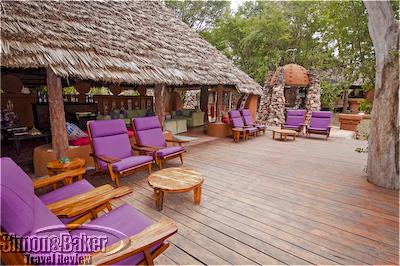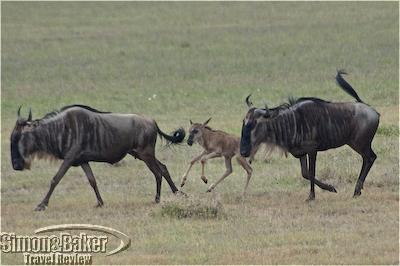

The camp was designed to make the most of the active wildlife of the river. The makuti (palm frond) covered lounge and dining areas morphed into sprawling decks that reached out to the water. An oversize circular plunge pool overlooked the hippos’ favorite bathing spot. Bright deck furniture complemented the cheerful interior décor for an inviting indoor-outdoor living experience. Barring one evening when a sudden dinnertime thunderstorm dictated otherwise, I enjoyed taking my meals on the deck. My own accommodations, a luxurious tent on a concrete slab under a high makuti canopy, had a comfortably furnished veranda facing the river. I loved to settle there with my early morning cup of tea and observe the rich birdlife around me, and the frequent territorial arguments of the hippos.
But when I think of Grumeti Serengeti Tented Camp, beyond the great game viewing experience and the superb accommodations that are de rigueur for a luxury safari property in this renowned corner of Tanzania, I remember most the whimsical atmosphere of the camp and the enthusiasm of its staff. This rare combination made it very special indeed: a fun place to be. There were bursts of vibrant colors and quirky decorating elements throughout the camp, such as a collection polychrome woodcarvings of bygone bush explorers from pocket size to life-size, gathered in a corner of the lounge and paired with a display of jewel-like Kenyan hand-blown glass pieces. Nods to local artistry popped up in unexpected places. Bright, finely beaded light fixtures recalled the work of Masai women, as did the primary colors and naïve design of wall hangings in the lounge and suite. There was local metalwork everywhere, from the large mirror frame in my bathroom to the intricately cutout tin backdrop of the bar in the center of the common areas. There were so many tongue-in-cheek details scattered about that they invited a treasure hunt. I kept noticing new surprises until the moment of my departure.
As for the staff, they were a well-trained, attentive team, obviously proud of their camp and eager to ensure that I would enjoy every instant of my stay with them. I did. The welcome dance from the assembled staff that greeted me on arrival set the tone. As soon as May Kobero, the camp manager, ensured I was satisfactorily settled in, my personal butler, Stanley, took over. He had a table ready for me under a market umbrella on the deck, and within minutes he appeared from the kitchen bearing a tray laden with a scrumptious three-course lunch of cucumber soup, fresh pasta, warm rosemary bread and a green salad, to be followed by fresh mango sorbet. Later that evening, after a breathtaking sunset drive, my guide, Killian, delivered me to an open area near camp, marked by a circle of glowing oil lamps and a roaring campfire. After a lavish barbecue dinner, the entire team broke into a chorus of traditional African chants. Soon the singing evolved into a dance and an invitation to join in for a celebration of the starlit Serengeti night.
With its cheerful staff, playful atmosphere and intimate luxury setting in a rare riverside location, Grumeti Serengeti Tented Camp was the place for an unforgettable first encounter with this leading safari destination. I will consider it a mandatory stop on any future East African safari.
Children Children over the age of seven could be accommodated by prior arrangement
Class Of Accommodation Luxury safari camp
Communications My GSM 900/1800 compatible international cellular phone service was fully operational at the lodge and intermittently throughout the park.
Connectivity There was WiFi service in the lounge and dining room throughout the day and evening. The connection was reliable, with moderate speed.
Handicapped Access No
Length Of Stay Three nights
Location In the western corridor of the Serengeti National Park in northern Tanzania
Owned-Managed &Beyond Africa, previously known as Conservation Corporation Africa (CC Africa), with headquarters in Johannesburg, South Africa, owned and managed the property. At the time of this writing &Beyond itself is owned by two major shareholders, Capricorn (the Enthoven family, originally from South Africa) and the Getty Family Trust.
Power The camp was powered by diesel generators. Electricity was available from 6 a.m. to midnight. There was a convenient outlet in my room that could be used to charge my camera, phone and computer batteries.
Other Although the camp did not have a dedicated spa facility, there was a licensed masseuse on staff who offered a range of massage options in the guest tents. The camp closes for yearly maintenance from the end of March to the second week in May. &Beyond was voted Africa’s Leading Responsible Tourism Company at the 2010 World Travel Awards, and was honored with the prestigious Africa’s Leading Responsible Tourism Award.
Size The property consisted of 10 guest tents. It could accommodate a maximum of 23 guests and employed a staff of 40, including five guides and rangers. There were four game viewing vehicles.
Year Open-Renovated Originally opened in 1994, the camp was fully renovated in 2007. It receives thorough yearly maintenance and refurbishing.
To the left of the main entrance, a second makuti-covered space with a rear wall of rough stones and burnished concrete housed the dining area. A long serving buffet with a mirror chard mosaic front and a metal top occupied the rear wall. Dining tables were square distressed wood tops on roughly welded metal tubing bases. Coordinated metal chairs had high backs with tin inserts and thick seat cushions. On the deck, large market umbrellas shaded square wooden dining tables surrounded by director chairs. Throughout the dining space and lounging decks, seat cushions, director chairs inserts and umbrellas were covered in bright purple canvas. In the center of the common areas, the stand-alone bar stood under an adobe dome held by four rough stone pillars and topped by whimsical metal sculptures. The bar counter, shelves and backdrop were made of sheet metal with cutouts of ethnic shapes.
Tent My 430 square foot (40 square meter) tent, Number Nine, had a large front veranda overlooking the river. It stood on a burnished concrete base under a peaked makuti roof. The veranda had two lounge chairs with bright purple cushions and two matching director chairs at a round metal dining table. The tent had the usual zippered front entrance and sidewalls with three sets of net-covered windows. In front of the entrance, two contemporary violet canvas slipper chairs with bright red pillows faced each other across a round carved occasional table on a red tribal rug. A king size bed of pale Tanzanian cypress stood in the center of the room under a ceiling fan. The extra tall headboard divided the sleeping area from the bathroom at the rear of the tent. Reading lights with metal curlicue bases and beaded lampshades were attached to the headboard. Bedside tables were tooled metal cubes with glass tops.
Meals, bottled water, soft drinks and house alcoholic beverages were included, as were daily game viewing activities and daily laundry service. Top brand alcoholic beverages such as vintage wines, French champagnes and luxury whiskies were available for an additional charge.
Facilities There was a dining room, lounge, bar, swimming pool and gift shop.
Gift Shop A small cottage located a few steps from the main public areas carried a limited assortment of chic camp-branded safari wear, as well a few local craft items, mainly wood-carvings, antique trinkets and jewelry.
Pool At the far end of the lounge, a 13 foot (four meter) in diameter plunge pool was set in a deck overlooking the river. It was surrounded by seven lounge chairs with the trademark purple cushions and umbrellas. Peach pool towels were folded at the foot of each chair.
Game I sighted included olive baboon, buffalo, bushbuck, Nile crocodile, Kirk’s dik-dik, eland, elephant, Grant’s gazelle, Thomson’s gazelle, giraffe, hippo, spotted hyena, impala, black-backed jackal, lion, colobus monkey, banded mongoose, dwarf mongoose, ostrich, reedbuck, topi, vervet monkey, leopard turtle, warthog, white-bearded wildebeest and zebra. Birds included kori bustard, white-bellied bustard, fan-tailed cisticola, Klaas’s cuckoo, white browed coucal, fork tailed drongo, battelier eagle, tawny eagle, grey-backed fiscal, dark chanting goshawk, hammerkop, gray heron, African crested hoopoe, grey hornbill, common kestrel, grey lourie, marsh harrier, African Scops owl, lilac-breasted roller, secretary bird, superb starling, Ruppell’s long tailed starling, Abdim’s stork, lappet-faced vulture, white-headed buffalo weaver and golden weaver.
Date Of Visit February 2011
Reviewers Article and photos by Josette King
Service My tent was serviced twice daily. My personal butler was pleasant, prompt and thoughtful. Every member of the staff was friendly and efficient. My guide was knowledgeable and attentive.
Would You Stay There Again? Yes
Contact Information
- &Beyond Tanzania
- Private Bag X 27
- Benmore, Johannesburg
- 2010, South Africa
- + 255 27 254 4295
- (emergency 24×7)
- + 255 787 551108
- + 255 27 254 8268
- http://www.andbeyondafrica.com/luxury_safari/tanzania/serengeti_national_park/and_beyond_grumeti














